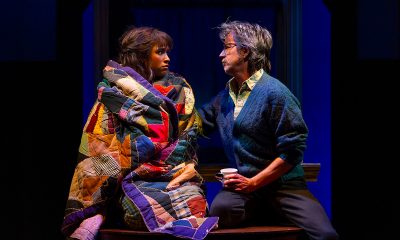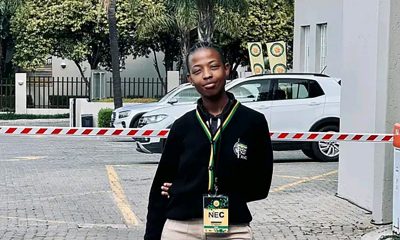a&e features
Ain’t life Grand
‘All American Boy’ on funneling fame into something sustainable
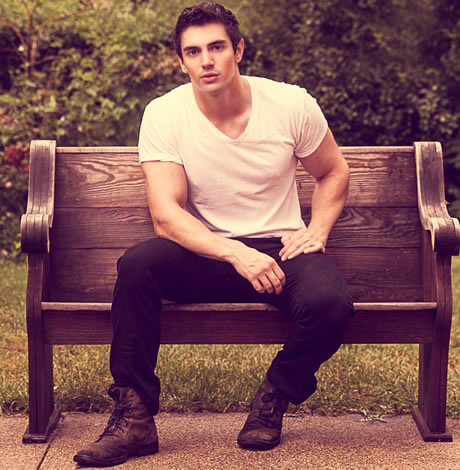
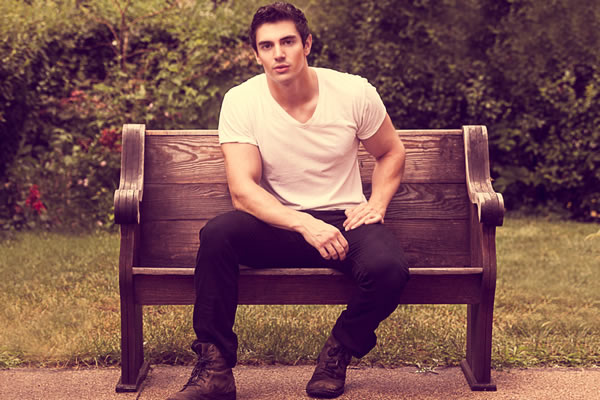
Singer Steve Grand says he is not driven by financial payoff when making music. (Photo by Christopher Free)
Steve Grand says it’s become trendy for gay celebs to come out in an “oh-by-the-way”-type manner. The 25-year-old singer/songwriter says that was never his style.
“People say this is no big deal anymore, who cares,” he says. “You know who cares? The kids who are still really struggling with this. The kids who feel like they would still rather be dead than live life as a gay person. I’m thinking about them all the time when I’m doing these things because deep down, we all just want to be loved. … We want to feel valued and understood.”
In 2013, the Chicago native took $7,000 of his own money to make a music video for his song “All-American Boy.” The now-famous clip — nearly 4 million YouTube hits logged — found him jamming roots-rock style (many called it country) and pining for a straight friend. Now having raised $325,000 from 5,000 fans through a Kickstarter campaign, Grand is releasing a 13-track album of the same name. The Aaron-Johnson-produced project is slated for a March 24 release. We caught up with Grand from his Chicago home by phone. His comments have been slightly edited for length.
WASHINGTON BLADE: Nobody sets out to be a one-hit wonder. You seem like you’re on a logical path to spinning the attention from the video into a sustainable career. How easy or hard has that been so far?
STEVE GRAND: I think I did a good job of keeping my feet on the ground. I went through the whole viral Internet star thing and that was big for a short time. I fumbled a bit in interviews and was trying to figure out if I was going to do shows right away, work on an album. There really was no plan and looking back it seems almost like a hindrance that the video and song came together so beautifully because I don’t think people realized it was really just me doing all that. People suddenly had all these really high expectations right away and I didn’t have a team, no manager, label, it was just something I did all myself with my own money made from playing bars on weekends. … It gave me a good jumpstart and exposed my music to a lot of people right off the bat and connected with a lot of people. I have to be grateful for that but it has a dark side too, for sure.
BLADE: Obviously the video wasn’t just something you did off the cuff. How calculated was it?
GRAND: I really wanted to start a grassroots kind of thing and I thought if I put it out there and people responded, that would be a good start to establishing myself as an artist so I just started asking around, finding people who did videos and eventually I met up with (director) Jason Knade. … I think I really stretched everyone and got a lot for my money. I was very passionate about it and I really cared about getting that song and video out to the world … but no, it wasn’t calculated in terms of anything after. I’ve said this a few times and it doesn’t seem to really stick, but I really did just upload it to YouTube and put it on Facebook and then the Internet did its thing. I wasn’t even sure who to reach out to. I remember thinking, “Oh, maybe I should e-mail Davy Wavey or something,” but it just did its own thing. Buzzfeed got it the next day and said I was the first openly gay country singer and I was like, “What?” I never really stood by that title but I was glad people were seeing it.
BLADE: When was it filmed and how long did it take?
GRAND: We filmed it in June of 2013 and shot it over three days. It was really hard trying to find a yard that we could bring all my friends as extras and have a place that looked like open roads and a campfire and light off fireworks and not get in trouble. I had so much trouble getting a place. No one wants to lend their place to a bunch of 23 year olds with cameras, fireworks and alcohol, but we did end up finding a place in Wisconsin through a friend of a friend. I invited like 200 people knowing maybe 30 would show up and I was right. We shot two days back to back, then a week later shot the stuff in a friend’s yard where it looks like the morning after with the fire and the garbage. Then we edited it right away.
BLADE: I guess people were skeptical because it looked so professionally done. So many essentially homemade videos end up looking so cheesy. How did you avoid that?
GRAND: Well, I insisted on looking at all the footage we shot even though nobody wants to do that because it’s so crazy, but I insisted. I was like, “Give me the footage.” I wanted to be sure we had absolutely the best shot of everything so I spent hours and hours going through it. I also really needed it to be up by the Fourth of July, that was my plan, me being calculating I guess. I thought that was the best time to release it so we had a very limited amount of time. The editor had his first edit, then we spent eight hours going over everything making tweaks. … I really just knew exactly how I wanted it to look and I knew the feeling I wanted people to have and how to achieve that. I was very inspired and very determined and also lucky to have some very talented people to help. … I drove myself nuts, though. My parents were starting to get really worried. They were like, “It’s a little scary how you’re so intense about this.” I wasn’t sleeping or eating, which honestly is why I look so ripped in the video. It was really going over every last detail right up until the last minute.
BLADE: When hip-hop made its mark on pop, country started sounding a lot like where pop/rock was in the ‘90s. Do you think that’s why you got the country sticker?
GRAND: Yeah, live drums, acoustic guitar now, people think country. And also the storytelling style and a lot of the visuals with American flags, old cars, friends by the fire, whisky — those are very country images I guess. I just think of them as Americana. I’ve never gotten too hung up on what it’s called. … If it sounds country to you, that’s fine. … I’m just all about making the song really shine and bringing out the beautiful raw elements of the song.
BLADE: There’s a lot of industry hand wringing about whether albums are obsolete. Why was it important to you to make one?
GRAND: It was something I always wanted to do. After “All American Boy” came out people were like, “You made it, you made it.” I’m like, “I haven’t done anything yet.” Until I have an album out and have played all over the country and the world, then I’ll feel I’ve done what I’ve wanted to do since I was 12. Right after “All American Boy,” all these offers came in, all this stupid shit like reality TV and you know, people saying you have to decide today what you want your career to be like. … My thinking all along was if I’m a good songwriter and a good performer and I think there’s an audience out there for me, if that is all true, then there should still be something left when this moment fades away.
BLADE: Will you tour?
GRAND: Yeah, later in the spring. We’re doing this thing in Europe for two weeks in June and the rest is being put together now.
BLADE: How did you feel watching Sam Smith at the Grammys?
GRAND: It was amazing and a testament to where we are today, which is a beautiful thing. I thought about what it would have meant to me as a young person to have seen something like that — Sam Smith just owning the Grammys, that was amazing. He’s obviously just so, so good and the industry has really embraced him. People everywhere just seem to really like him.
BLADE: What album did you wear out when you were 12-13-14?
GRAND: Fall Out Boy, “Take This to Your Grave.” I listened to that like crazy. That’s when that whole pop-funk-emo thing was happening.
BLADE: You played a lot in clubs and churches. What did you learn?
GRAND: How to be in front of people and give them an experience even when I wasn’t feeling it. You learn to perform and be on whether you’re having a bad day, hung over, sometimes sick, whatever. I learned it was my job to still play and make people happy.
BLADE: There’s no money in having a huge YouTube hit and not that I sense you’re doing all this for the money but surely in time you want to be able to sustain yourself doing this. You put a lot of money into the video. Was it worth it?
GRAND: Anytime somebody thinks I’m doing this for the money, I just laugh forever. I actually moved out of my apartment and back into my parents’ basement because I wanted to keep investing in myself and not throwing hundreds of dollars away for an apartment I was barely at anyway because I was spending so much time traveling to L.A. and recording. People have all sorts of priorities and so far, mine has been putting out something beautiful in the world, something people will connect to and giving people an experience. … I don’t care about living a glamorous life.
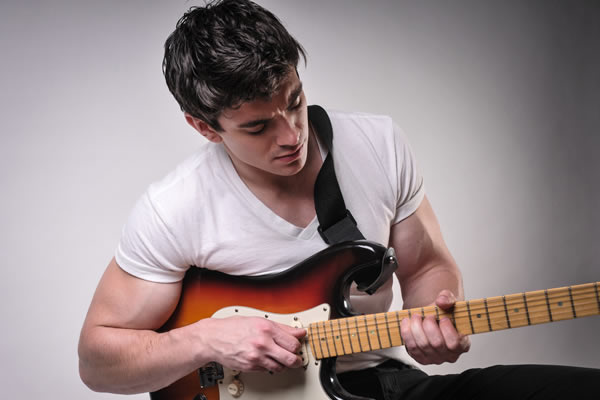
Steve Grand says he knew his ‘All American Boy’ video would be successful. (Photo by Joem Bayawa)
BLADE: You’ve done a lot of scantily clad photo shoots. Do all the underwear shots risk undermining a serious career?
GRAND: Those were all done when I was 19, so like six years ago. I didn’t do drugs or anything. My way of rebelling was taking off my clothes. I don’t own them and don’t choose my Google search so there’s nothing I can do about it. I’m not ashamed of them and I don’t feel like they’re any big deal … but most of the time now I don’t care how I look. Sometimes I’ll do a show now and people say, “Take off your shirt.” The only time I did that was for the ALS Ice Bucket Challenge in Lake Superior. But now, I don’t really care about showing off my body.
BLADE: Whatever ingredients are needed to launch a successful pop career in 2015 — whatever combination of looks, talent, and so on, to say nothing of drive, it would seem you were dealt a pretty good hand in life. Would you concur?
GRAND: Oh yeah, I’m never one to downplay that, absolutely. We’re not all dealt the same hand. I think I’m lucky to a certain extent but also lucky to have work ethic and passion and to care about what I do. … You really have to be in this for the right reasons because if you’re not, it’s just not worth it.
BLADE: You’ve said before in interviews you were not dating but focusing on career development. Is that still the case?
GRAND: Absolutely. And even if I was, I wouldn’t say. I like to keep some things to myself. I love life and sex and all that, but that’s for me.
a&e features
Doug Spearman takes his chance
‘Noah’s Arc: The Movie’ debuted on Paramount+ last month
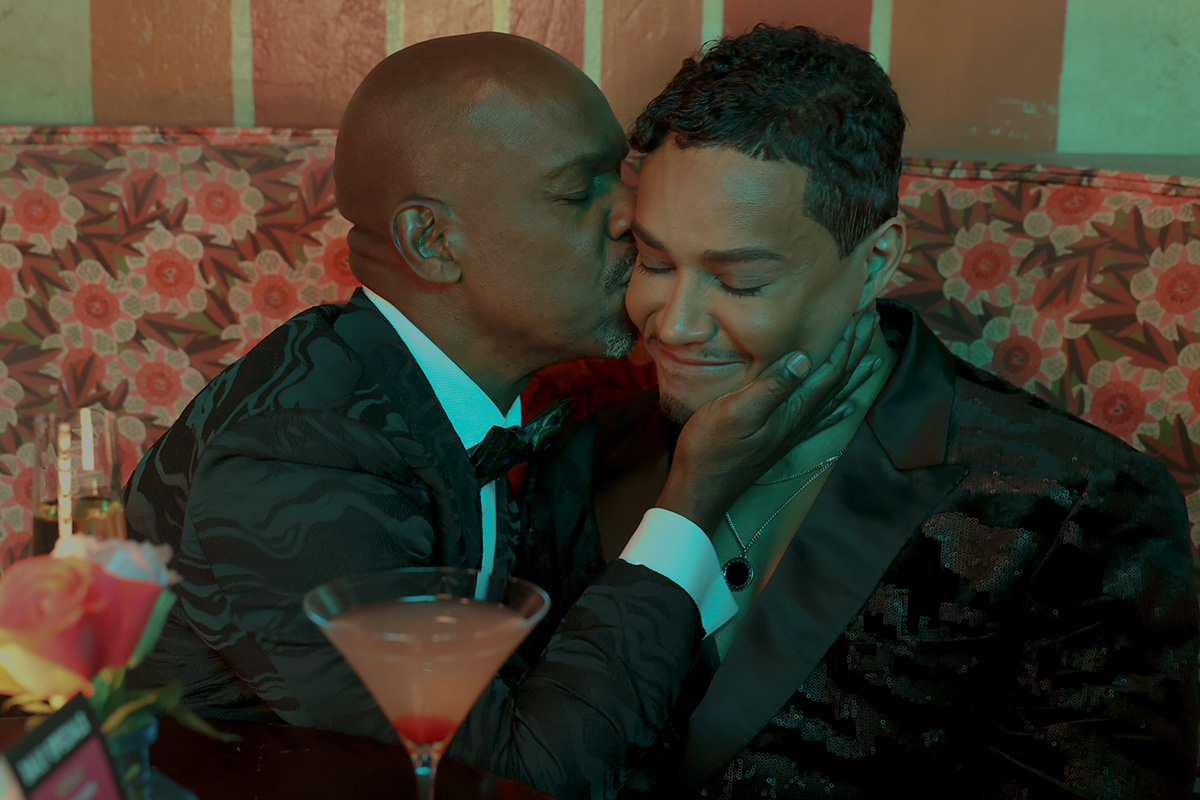
There’s no question that when Patrik-Ian Polk’s series “Noah’s Arc” premiered on Logo 20 years ago, it was a groundbreaking creation. The story of a group of Black gay men and their wonderful friendship. The titular arc was that of the cute main character, Noah (Darryl Stephens), and his close-knit circle of friends, including Chance played by gay actor Doug Spearman. This compelling and loving fraternity may, in fact, be what brought viewers back repeatedly, including a 2008 movie, “Noah’s Arc: Jumping the Broom,” as well as the 2020 “Noah’s Arc” short, and now, a new full-length feature “Noah’s Arc: The Movie,” debuting on Paramount+ on June 20. In the movie, filled with equal measures of laughs and tears, Chance, who has faced a devastating loss, finds his dependable friends there, ready to support and comfort him at a moment’s notice. I had the pleasure of speaking with Spearman the morning of the streaming premiere of “Noah’s Arc: The Movie.”
WASHINGTON BLADE: Doug, since the early 2000s, when the “Noah’s Arc” series premiered on Logo, you have been playing the character of Chance, including in the latest installment, “Noah’s Arc: The Movie.” What was it about Chance that appealed to you as an actor?
SPEARMAN: When Patrik (-Ian Polk) called me to ask me to play him (Chance), I was at JFK airport in the baggage claim, waiting for a suitcase. He explained what the part was. The thing that stuck out to me was the fact that Chance was in a long-term relationship with another Black man. And, they had a child; they had a 4-year-old daughter named Kenya. I had never seen two Black gay men raise a child on TV before. I thought it was the most revolutionary thing I’d ever seen. I immediately thought I’ve got to do this because that was something nobody had seen. I thought it was incredibly important to take the part.
BLADE: “Noah’s Arc: The Movie” was, once again, written and directed by Patrik-Ian Polk, who you just mentioned, is the creator of the entire franchise. What’s the secret to your long-standing working relationship?
SPEARMAN: [Laughs] the whole team, all of us, are like a band of brothers. We fight like brothers, we come together like brothers, we hash things out, we talk, because we’re all very different from our characters. I think the challenge of playing these guys and then uplifting these men, playing a part, especially something written by Patrik, is like solving a math equation. There’s always a challenge that’s enjoyable for me as an actor: to try to find out what it is that Patrik wants, and then how do I do it.
BLADE: I think you do a very good job of it.
SPEARMAN: Thank you very much
BLADE: In the years between “Jumping the Broom” and the new full-length movie, many changes have occurred, and the story addresses some of them, including gay widowhood, which is something that the aging community is now confronting, as well as mental health issues. Please say a few words about how you approached those subjects in the new movie.
SPEARMAN: I had a lot of loss in my life, right before we started shooting. Two months before we started shooting the first series, my mother died. I was going through the grief process through that whole first season. Since then, I’ve lost a lot of people in my life. In fact, when we started shooting the second season, the second week we were shooting, my ex died of a heart attack. I was having to fold that into what I was doing with my life on the set and off the set. You’ve got to show up and you’ve got to do your work. The first two seasons of “Noah’s Arc” are always tinged with the memory of grief. So, when I had to deal with the death that Chance faces (in the new movie), which is a significant death in his life, it wasn’t that hard to reach back, especially the scene in the graveyard. It was something that I unfortunately could pull from personal experience.
BLADE: Shifting gears, the movie features delightful cast surprises, including Jasmine Guy and TS Madison. Did you have a chance to interact with either or both when they were on set?
SPEARMAN: No, I didn’t have any scenes with Jasmine, and I missed her. I wish I had gotten to see her because I actually got to direct Jasmine for a CBS promo shoot for “Queen,” back in the early ‘90s. I had a huge crush on her when she was on “A Different World.” So, I really would have liked to reconnect. But TS and I got to see each other every day because I was in all her scenes. It was extraordinary being around somebody like that. That is one outspoken woman!
BLADE: Even though Beyoncé never makes an appearance in the movie, there’s a lot of talk about her. Would you say you are a Beyoncé fan?
SPEARMAN: Yes! I’m breathing! Yes, I’m a Beyoncé fan. I actually got the chance to meet her. I knew her mom. Her mom was extraordinary to me. She is in the second movie I directed. She also gave us a wedding gown to use in the very first scene of the movie. That family is extraordinarily important to me. Not only just to be a fan, but to be somebody who’s gotten to know them and work with them and see how hard they work. I don’t think anybody works as hard as Tina or Beyoncé.
BLADE: There was a recent news item about gay actor Benito Skinner of the Amazon Prime series “Overcompensating” being told not to bother auditioning for straight roles. As an out actor yourself, how important do you think it is for queer characters to be portrayed by queer actors, and vice versa?
SPEARMAN: Being queer is a multifaceted identity. There’s no one kind of queer person. I think finding the best actor that’s your first circle of casting. I think one of the joys about being an actor is that you get to play different parts. I play straight guys all the time. Dads and husbands and things like that. I think a lot of people are told not to do it. In fact, I wouldn’t be Chance if the actor who was originally cast as Chance hadn’t been pulled out of the series by his agents because they didn’t want him to play a gay character.
BLADE: That’s amazing! Thank you for sharing that. Without giving away too much, the ending of the movie is a little ambiguous, even ending with a question mark. If there was a “Noah’s Arc: The Movie” sequel, would you come back for that?
SPEARMAN: Yeah! A lot of it would depend on what Chance’s journey is going to be like. Patrik and I have conversations like that all the time. He’s very interested and supportive of input. I hope I would be, as we all would be, part of the creative growth with these characters. They live in Patrik’s head, and he writes them, but we’re the ones who have to flesh them out. It’s a conversation, it’s always a conversation.
BLADE: You are currently performing in Molière’s “The Imaginary Invalid” as part of the New Orleans Shakespeare Festival at Tulane. What has this experience been like for you?
SPEARMAN: It’s extraordinary! I started on stage when I was seven. There’s nothing like working with a live audience and having that immediacy. I’m working with an extraordinarily talented cast in a really great play, and I have some of the best scene partners I could ever want.
BLADE: Are there any upcoming film or TV projects you’d like to mention?
SPEARMAN: I’m still a writer, and I’m still a director, and I’ve still got scripts that I would like to make. I have a little something that’s a cross between “Treme” and “Bridgerton” that I want to do. I’m always trying to figure out what the next thing is.
a&e features
Visit Cambridge, a ‘beautiful secret’ on Maryland’s Eastern Shore
New organization promotes town’s welcoming vibe, LGBTQ inclusion
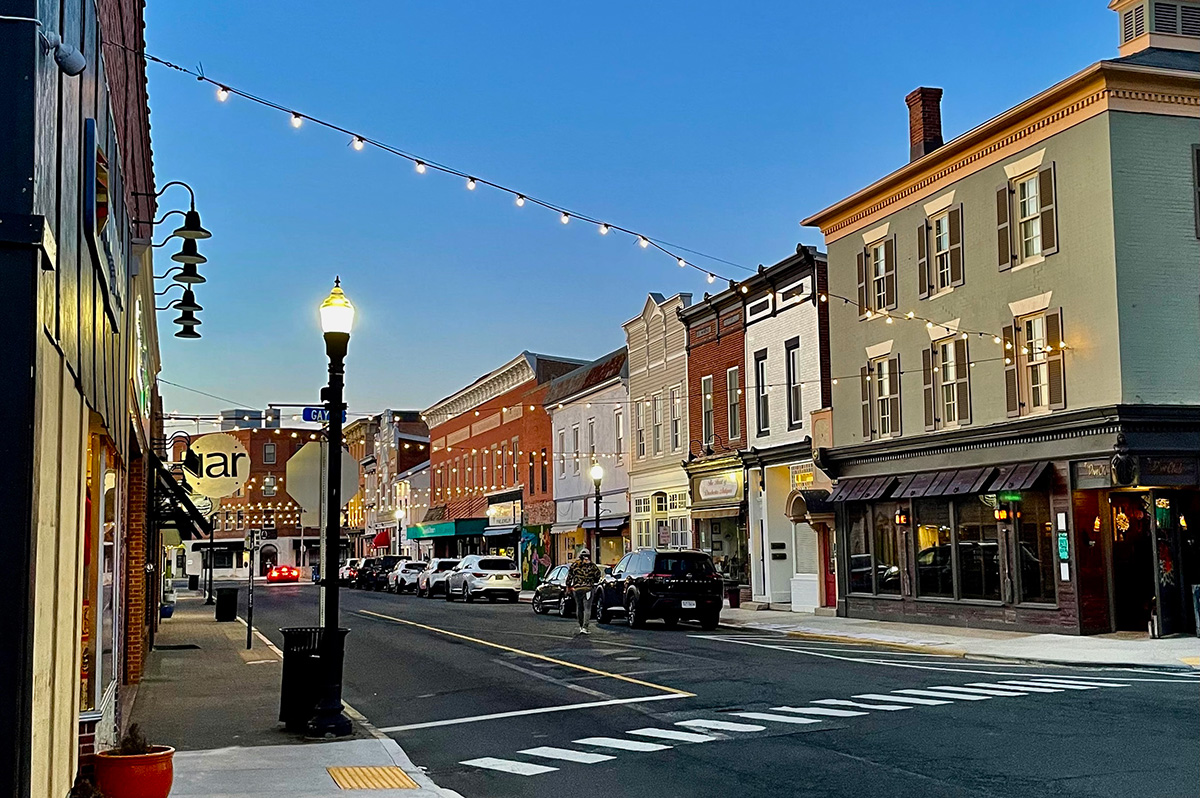
CAMBRIDGE, Md. — Driving through this scenic, historic town on Maryland’s Eastern Shore, you’ll be charmed by streets lined with unique shops, restaurants, and beautifully restored Victorian homes. You’ll also be struck by the number of LGBTQ Pride flags flying throughout the town.
The flags are a reassuring signal that everyone is welcome here, despite the town’s location in ruby red Dorchester County, which voted for Donald Trump over Kamala Harris by a lopsided margin. But don’t let that deter you from visiting. A new organization, Proudly Cambridge, is holding its debut Pride event this weekend, touting the town’s welcoming, inclusive culture.
“We stumbled on a beautiful secret and we wanted to help get the word out,” said James Lumalcuri of the effort to create Proudly Cambridge.
The organization celebrates diversity, enhances public spaces, and seeks to uplift all that Cambridge has to share, according to its mission statement, under the tagline “You Belong Here.”
The group has so far held informal movie nights and a picnic and garden party; the launch party is June 28 at the Cambridge Yacht Club, which will feature a Pride celebration and tea dance. The event’s 75 tickets sold out quickly and proceeds benefit DoCo Pride.
“Tickets went faster than we imagined and we’re bummed we can’t welcome everyone who wanted to come,” Lumalcuri said, adding that organizers plan to make “Cheers on the Choptank” an annual event with added capacity next year.
One of the group’s first projects was to distribute free Pride flags to anyone who requested one and the result is a visually striking display of a large number of flags flying all over town. Up next: Proudly Cambridge plans to roll out a program offering affirming businesses rainbow crab stickers to show their inclusiveness and LGBTQ support. The group also wants to engage with potential visitors and homebuyers.
“We want to spread the word outside of Cambridge — in D.C. and Baltimore — who don’t know about Cambridge,” Lumalcuri said. “We want them to come and know we are a safe haven. You can exist here and feel comfortable and supported by neighbors in a way that we didn’t anticipate when we moved here.”
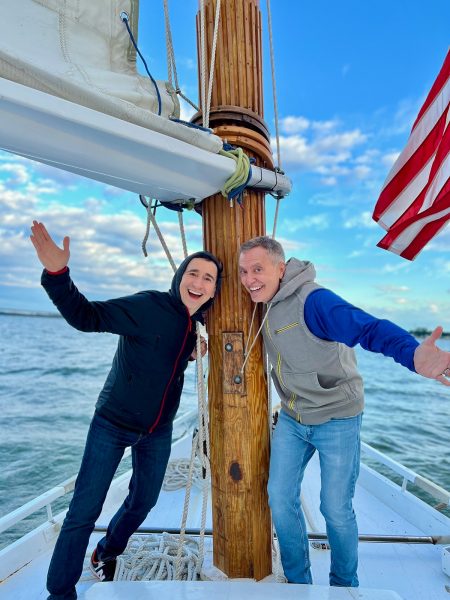
Lumalcuri, 53, a federal government employee, and his husband, Lou Cardenas, 62, a Realtor, purchased a Victorian house in Cambridge in 2021 and embarked on an extensive renovation. The couple also owns a home in Adams Morgan in D.C.
“We saw the opportunity here and wanted to share it with others,” Cardenas said. “There’s lots of housing inventory in the $300-400,000 range … we’re not here to gentrify people out of town because a lot of these homes are just empty and need to be fixed up and we’re happy to be a part of that.”
Lumalcuri was talking with friends one Sunday last year at the gazebo (affectionately known as the “gayzebo” by locals) at the Yacht Club and the idea for Proudly Cambridge was born. The founding board members are Lumalcuri, Corey van Vlymen, Brian Orjuela, Lauren Mross, and Caleb Holland. The group is currently working toward forming a 501(c)3.
“We need visibility and support for those who need it,” Mross said. “We started making lists of what we wanted to do and the five of us ran with it. We started meeting weekly and solidified what we wanted to do.”
Mross, 50, a brand strategist and web designer, moved to Cambridge from Atlanta with her wife three years ago. They knew they wanted to be near the water and farther north and began researching their options when they discovered Cambridge.
“I had not heard of Cambridge but the location seemed perfect,” she said. “I pointed on a map and said this is where we’re going to move.”
The couple packed up, bought a camper trailer and parked it in different campsites but kept coming back to Cambridge.
“I didn’t know how right it was until we moved here,” she said. “It’s the most welcoming place … there’s an energy vortex here – how did so many cool, progressive people end up in one place?”
Corey van Vlymen and his husband live in D.C. and were looking for a second home. They considered Lost River, W.Va., but decided they preferred to be on the water.
“We looked at a map on both sides of the bay and came to Cambridge on a Saturday and bought a house that day,” said van Vlymen, 39, a senior scientist at Booz Allen Hamilton. They’ve owned in Cambridge for two years.
They were drawn to Cambridge due to its location on the water, the affordable housing inventory, and its proximity to D.C.; it’s about an hour and 20 minutes away.
Now, through the work of Proudly Cambridge, they hope to highlight the town’s many attributes to residents and visitors alike.
“Something we all agree on is there’s a perception problem for Cambridge and a lack of awareness,” van Vlymen said. “If you tell someone you’re going to Cambridge, chances are they think, ‘England or Massachusetts?’”
He cited the affordability and the opportunity to save older, historic homes as a big draw for buyers.
“It’s all about celebrating all the things that make Cambridge great,” Mross added. “Our monthly social events are joyful and celebratory.” A recent game night drew about 70 people.
She noted that the goal is not to gentrify the town and push longtime residents out, but to uplift all the people who are already there while welcoming new visitors and future residents.
They also noted that Proudly Cambridge does not seek to supplant existing Pride-focused organizations. Dorchester County Pride organizes countywide Pride events and Delmarva Pride was held in nearby Easton two weeks ago.
“We celebrate all diversity but are gay powered and gay led,” Mross noted.
To learn more about Proudly Cambridge, visit the group on Facebook and Instagram.
What to see and do
Cambridge, located 13 miles up the Choptank River from the Chesapeake Bay, has a population of roughly 15,000. It was settled in 1684 and named for the English university town in 1686. It is home to the Harriet Tubman Museum, mural, and monument. Its proximity to the Blackwater National Wildlife Refuge makes it a popular stop for birders, drawn to more than 27,000 acres of marshland dubbed “the Everglades of the north.”
The refuge is walkable, bikeable, and driveable, making it an accessible attraction for all. There are kayaking and biking tours through Blackwater Adventures (blackwateradventuresmd.com).
Back in town, take a stroll along the water and through historic downtown and admire the architecture. Take in the striking Harriet Tubman mural (424 Race St.). Shop in the many local boutiques, and don’t miss the gay-owned Shorelife Home and Gifts (421 Race St.), filled with stylish coastal décor items.
Stop for breakfast or lunch at Black Water Bakery (429 Race St.), which offers a full compliment of coffee drinks along with a build-your-own mimosa bar and a full menu of creative cocktails.
The Cambridge Yacht Club (1 Mill St.) is always bustling but you need to be a member to get in. Snapper’s on the water is temporarily closed for renovations. RaR Brewing (rarbrewing.com) is popular for craft beers served in an 80-year-old former pool hall and bowling alley. The menu offers burgers, wings, and other bar fare.
For dinner or wine, don’t miss the fantastic Vintage 414 (414 Race St.), which offers lunch, dinner, wine tasting events, specialty foods, and a large selection of wines. The homemade cheddar crackers, inventive flatbreads, and creative desserts (citrus olive oil cake, carrot cake trifle) were a hit on a recent visit.
Also nearby is Ava’s (305 High St.), a regional chain offering outstanding Italian dishes, pizzas, and more.
For something off the beaten path, visit Emily’s Produce (22143 Church Creek Rd.) for its nursery, produce, and prepared meals.
“Ten minutes into the sticks there’s a place called Emily’s Produce, where you can pay $5 and walk through a field and pick sunflowers, blueberries, you can feed the goats … and they have great food,” van Vlymen said.
As for accommodations, there’s the Hyatt Regency Chesapeake Bay (100 Heron Blvd. at Route 50), a resort complex with golf course, spa, and marina. Otherwise, check out Airbnb and VRBO for short-term rentals closer to downtown.
Its proximity to D.C. and Baltimore makes Cambridge an ideal weekend getaway. The large LGBTQ population is welcoming and they are happy to talk up their town and show you around.
“There’s a closeness among the neighbors that I wasn’t feeling in D.C.,” Lumalcuri said. “We look after each other.”
a&e features
James Baldwin bio shows how much of his life is revealed in his work
‘A Love Story’ is first major book on acclaimed author’s life in 30 years

‘Baldwin: A Love Story’
By Nicholas Boggs
c.2025, FSG
$35/704 pages
“Baldwin: A Love Story” is a sympathetic biography, the first major one in 30 years, of acclaimed Black gay writer James Baldwin. Drawing on Baldwin’s fiction, essays, and letters, Nicolas Boggs, a white writer who rediscovered and co-edited a new edition of a long-lost Baldwin book, explores Baldwin’s life and work through focusing on his lovers, mentors, and inspirations.
The book begins with a quick look at Baldwin’s childhood in Harlem, and his difficult relationship with his religious, angry stepfather. Baldwin’s experience with Orilla Miller, a white teacher who encouraged the boy’s writing and took him to plays and movies, even against his father’s wishes, helped shape his life and tempered his feelings toward white people. When Baldwin later joined a church and became a child preacher, though, he felt conflicted between academic success and religious demands, even denouncing Miller at one point. In a fascinating late essay, Baldwin also described his teenage sexual relationship with a mobster, who showed him off in public.
Baldwin’s romantic life was complicated, as he preferred men who were not outwardly gay. Indeed, many would marry women and have children while also involved with Baldwin. Still, they would often remain friends and enabled Baldwin’s work. Lucien Happersberger, who met Baldwin while both were living in Paris, sent him to a Swiss village, where he wrote his first novel, “Go Tell It on the Mountain,” as well as an essay, “Stranger in the Village,” about the oddness of being the first Black person many villagers had ever seen. Baldwin met Turkish actor Engin Cezzar in New York at the Actors’ Studio; Baldwin later spent time in Istanbul with Cezzar and his wife, finishing “Another Country” and directing a controversial play about Turkish prisoners that depicted sexuality and gender.
Baldwin collaborated with French artist Yoran Cazac on a children’s book, which later vanished. Boggs writes of his excitement about coming across this book while a student at Yale and how he later interviewed Cazac and his wife while also republishing the book. Baldwin also had many tumultuous sexual relationships with young men whom he tried to mentor and shape, most of which led to drama and despair.
The book carefully examines Baldwin’s development as a writer. “Go Tell It on the Mountain” draws heavily on his early life, giving subtle signs of the main character John’s sexuality, while “Giovanni’s Room” bravely and openly shows a homosexual relationship, highly controversial at the time. “If Beale Street Could Talk” features a woman as its main character and narrator, the first time Baldwin wrote fully through a woman’s perspective. His essays feel deeply personal, even if they do not reveal everything; Lucian is the unnamed visiting friend in one who the police briefly detained along with Baldwin. He found New York too distracting to write, spending his time there with friends and family or on business. He was close friends with modernist painter Beauford Delaney, also gay, who helped Baldwin see that a Black man could thrive as an artist. Delaney would later move to France, staying near Baldwin’s home.
An epilogue has Boggs writing about encountering Baldwin’s work as one of the few white students in a majority-Black school. It helpfully reminds us that Baldwin connects to all who feel different, no matter their race, sexuality, gender, or class. A well-written, easy-flowing biography, with many excerpts from Baldwin’s writing, it shows how much of his life is revealed in his work. Let’s hope it encourages reading the work, either again or for the first time.



















